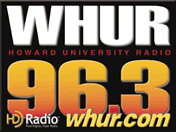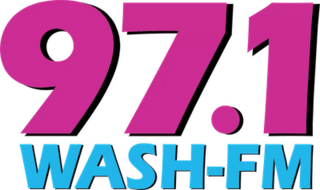Related Research Articles
FM broadcasting in the United States began in the 1930s at engineer and inventor Edwin Howard Armstrong's experimental station, W2XMN. The use of FM radio has been associated with higher sound quality in music radio.

The FM broadcast band is a range of radio frequencies used for FM broadcasting by radio stations. The range of frequencies used differs between different parts of the world. In Europe and Africa and in Australia and New Zealand, it spans from 87.5 to 108 megahertz (MHz) - also known as VHF Band II - while in the Americas it ranges from 88 to 108 MHz. The FM broadcast band in Japan uses 76 to 95 MHz, and in Brazil, 76 to 108 MHz. The International Radio and Television Organisation (OIRT) band in Eastern Europe is from 65.9 to 74.0 MHz, although these countries now primarily use the 87.5 to 108 MHz band, as in the case of Russia. Some other countries have already discontinued the OIRT band and have changed to the 87.5 to 108 MHz band.
WQXR-FM is an American non-commercial classical radio station, licensed to Newark, New Jersey, and serving the North Jersey and New York City area. It is owned by the nonprofit organization New York Public Radio (NYPR), which also operates WNYC (AM), WNYC-FM and the four-station New Jersey Public Radio group. WQXR-FM broadcasts from studios and offices located in the Hudson Square neighborhood in lower Manhattan and its transmitter is located at the Empire State Building. The station is the core audio service for NYPR's WQXR brand.

WHUR-FM is an urban adult contemporary radio station that is licensed to Washington, D.C., and serving the Metro D.C. area. It is owned and operated by Howard University, making it one of the few commercial radio stations in the United States to be owned by a college or university, as well as being the only independent, locally-owned station in the Washington, D.C., area. Staff members of the station mentor the students of the university's school of communications. The studios are located on campus in its Lower Quad portion, and the transmitter tower is based in the Tenleytown neighborhood. It is also co-owned with its television partner, WHUT-TV, one of D.C.'s PBS affiliates.

WASH is a commercial FM radio station owned and operated by iHeartMedia and located in Washington, D.C. Known on-air as "WASH-FM", the station airs an adult contemporary radio format. Studios and offices are on Rockville Pike in Rockville, Maryland. The station has an effective radiated power (ERP) of 17,500 watts, broadcasting from a tower at 242 metres (794 ft) in height above average terrain (HAAT). The transmitter site is on Chesapeake Street NW off Wisconsin Avenue in the Tenleytown neighborhood of Washington, D.C. With a good radio, WASH coverage extends from Baltimore to Fredericksburg, Virginia.

WUKY is a listener-supported, public radio station in Lexington, Kentucky. Owned by the University of Kentucky (UK), it has an Adult Album Alternative radio format, airing more than 100 hours of music per week. Some news and informational programming is supplied by National Public Radio (NPR), Public Radio International (PRI), American Public Media (APM) and the BBC. The station broadcasts from state of the art radio studios in northwestern Lexington at the intersection of Greendale Road and Spurr Road.
Apex radio stations was the name commonly given to a short-lived group of United States broadcasting stations, which were used to evaluate transmitting on frequencies that were much higher than the ones used by standard amplitude modulation (AM) and shortwave stations. Their name came from the tall height of their transmitter antennas, which were needed because coverage was primarily limited to local line-of-sight distances. These stations were assigned to what at the time were described as "ultra-high shortwave" frequencies, between roughly 25 and 44 MHz. They employed amplitude modulation (AM) transmissions, although in most cases using a wider bandwidth than standard broadcast band AM stations, in order to provide high fidelity sound with less static and distortion.

WHCN is a commercial radio station licensed to Hartford, Connecticut. It broadcasts a classic hits radio format for the Hartford, Waterbury and New Haven areas, and is owned by iHeartMedia, Inc. It is branded "The River 105.9", a reference to the Connecticut River. Its studios and offices are located on Columbus Boulevard in Hartford.
This is a review of low-power television stations (LPTV) in the United States, transmitting on VHF channel 6, which also operate as radio stations capable of being picked up by many standard FM receivers. These stations are colloquially known as "Franken FMs", a reference to Frankenstein's monster, because TV stations functioning as radio stations had not been envisioned by the Federal Communications Commission (FCC). The FCC commonly refers to these stations as "FM6" operations. All of these FM transmissions are authorized for operation on a center frequency of 87.75 MHz.
WSM-FM was a commercial radio station that was operated by the National Life and Accident Insurance Company in Nashville, Tennessee, United States, beginning on March 1, 1941. Under its original call sign of W47NV, it was described at the time as the first fully licensed commercial FM station in the nation. However, after ten years of financial losses, the station ceased operations on March 15, 1951.
WA2XMN is an experimental FM radio station which broadcasts sporadically from the Armstrong Tower in Alpine, New Jersey. The station commemorates the pioneering broadcasts of the world's first FM radio station, W2XMN, built by Edwin Howard Armstrong, which began experimental broadcasts from this tower in June 1938 followed by full power broadcasting beginning on July 18, 1939. Armstrong's station signed off as KE2XCC on March 6, 1954.
W2XMN was an experimental FM radio station located in Alpine, New Jersey. It was constructed beginning in 1936 by Edwin Howard Armstrong in order to promote his invention of wide-band FM broadcasting. W2XMN was the first FM station to begin regular operations, and was used to introduce FM broadcasting to the general public in the New York City area. The station, in addition to being a testing site for transmitter and receiver development, was used for propagation studies and as an over-the-air relay station for distributing network programming to other FM stations in the region.
KE2XCC, first authorized in 1945 with the call sign W2XEA, was an experimental FM radio station located in Alpine, New Jersey and operated by inventor Edwin Howard Armstrong. It was located at the same site as Armstrong's original FM station, W2XMN, which dated to the late 1930s and primarily transmitted on the original FM "low band" frequencies. W2XEA was established as a companion station operating on the new FM "high band", which had been recently designated by the Federal Communications Commission as the replacement for the original FM station assignments. W2XMN shut down in 1949 after the "low band" was eliminated, and at this time W2XEA changed its call sign to KE2XCC and took over most of the functions previously performed by W2XMN.
WGTR was a pioneer commercial FM radio station, which was the first of two mountain-top stations established by the Yankee Network. It began regular programming, as experimental station W1XOJ, in 1939. In 1941 it was licensed for commercial operation from studios in Boston, initially with the call sign W43B, which was changed to WGTR in 1943. In 1947, its designated community of license was changed to Worcester, Massachusetts.
WMNE was a pioneer commercial FM radio station, which was the second of two mountain-top broadcasting stations established by the Yankee Network. It began regular programming, as experimental station W1XER, in December 1940. In 1941 it was licensed for commercial operation from studios in Boston, initially with the call sign W39B, which was changed to WMTW in 1943. In late 1946 the station's designated community of license was changed to Portland, Maine, and its call letters became WMNE.
WTMJ-FM was a pioneer commercial FM radio station, owned by the Journal Company, publishers of The Milwaukee Journal, and located in Milwaukee, Wisconsin. In the late 1940s, it was one of the first FM stations in America and among the most powerful. Although heavily promoted, the station was unprofitable and ceased operations in April 1950. Management foresaw a limited future, especially in contrast to recently introduced television broadcasting.
WBCA was a short-lived commercial FM radio station, licensed to Schenectady, New York. The station, originally W47A, launched on July 17, 1941, as the first commercial FM station without an associated AM station. The call sign was changed to WBCA in 1943. Despite initial optimism that FM stations would soon supplant the AM band, WBCA ceased operations in 1952 due essentially to the small number of FM receivers in use.
WMLL was an FM radio station in Evansville, Indiana, that began broadcasting, as W45V, in 1941. It was the first commercial FM station authorized in the state of Indiana. WMLL suspended operations and was deleted in 1956.
WNBF-FM was an FM radio station in Binghamton, New York, that began broadcasting, as W49BN, in 1942. It was the first commercial FM station authorized in the Southern Tier region. WNBF-FM suspended operations and was deleted in 1952.
References
- ↑ "FCC Order No. 67", Federal Register, May 25, 1940, page 2011.
- ↑ "Three FM Grants In New York Area", Broadcasting, June 23, 1941, page 18. The initial policy for commercial FM station call signs included an initial "W" for stations located east of the Mississippi River, followed by the last two digits of a station's frequency assignment, "31" in this case, and closing with a one or two character city identifier, which for New York metropolitan stations was "NY".
- ↑ "FM Rules to Speed Up Applications", Broadcasting, October 15, 1940, page 30.
- ↑ "FCC Sets Hearing On New York FM",Broadcasting, September 15, 1941, page 50.
- ↑ "FCC Authorization For 53 Commercial FM Outlets Given", Broadcasting, August 18, 1941, page 54.
- ↑ "Damm Is Elected At Meeting of FM Stations", Broadcasting, March 9, 1942, page 47.
- ↑ "Standard Broadcast Station Call Letters for All Outlets Starting Nov. 1, FCC Rule", The Billboard, September 4, 1943, page 7.
- ↑ "New Calls Named For FM Stations", Broadcasting, October 4, 1943, page 49.
- ↑ "FCC Allocates 88-106 mc Band to FM" by Bill Bailey, Broadcasting, July 2, 1945, pages 13-14.
- ↑ "FCC Allocations Order Text", Broadcasting, July 2, 1945, pages 64, 68.
- ↑ "Statements: Maj. E. H. Armstrong", Broadcasting, July 2, 1945, page 70.
- ↑ "Industry Supporting Decision on FM Move" by Bill Bailey, Broadcasting, July 9, 1945, page 18.
- ↑ "News of the Industry: Assignments and Standards for F-M", Electronics, November 1945, page 472.
- ↑ "FM Assignment Protests to be Heard", Broadcasting, October 8, 1945, page 77.
- ↑ "FCC Sets 231 AM Cases; Uses CBS FM Plan", Broadcasting, October 29, 1945, pages 15, 84.
- ↑ "Docket No. 6781: Table I" (October 26, 1945), Federal Communications Commission Reports (volume 11), page 1513.
- ↑ "New Frequency Assignments for FM Stations in the United States", Broadcasting, June 23, 1947, page 38.
- ↑ "Directory of FM Broadcasting Stations of the United States: New Jersey" (January 1, 1948), Broadcasting Yearbook (1948 edition), page 304.
- ↑ FCC History Cards for W2XEA (1945-1949) / KE2XCC (covering 1949-1952) (Federal Communications Commission)
- ↑ "Commercial FM Broadcasting Stations in U. S.", Broadcasting, July 22, 1946, page 66.
- ↑ "Facsimile Relay", Broadcasting, February 5, 1951, page 41.
- ↑ "Facsimile Facts" (letter from Edwin H. Armstrong), Broadcasting, February 19, 1951, page 18.
- ↑ "FCC Actions: July 21 Decisions: STA Extended", Broadcasting, July 25, 1949, page 83.
- ↑ "FCC Actions: August 21 Decisions: Extension of STA", Broadcasting, August 25, 1952, page 87.